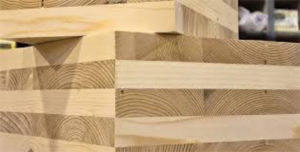The announcement from Timberlink Australia that it would invest in a state-of-the-art Cross Laminated Timber (CLT) and Glue Laminated Timber (Glulam) facility in the Green Triangle (South Australia and Victoria) indicates the growing market for engineered wood products. Sources: IndustryEdge, Timberbiz
An increasingly important element of mid-rise residential buildings in Australia, products like Glulam and CLT provide a range of advantages in the building process, including their light weight, ease of installation and cost-effectiveness in construction.
As population expansion, continued urbanisation and sustainable housing options all continue, the market must be expected to increase. For manufacturers, CLT and Glulam provide an opportunity to redirect wood resources that would otherwise generally be used to manufacture lower value sawn wood products.
Engineered wood products step timber up the value chain, supporting investment and creating jobs. In Timberlink’s case, by 2023, that could be as many as 50 new manufacturing jobs.
Timberlink’s softwood focussed facility follows the XLam manufacturing facility in Albury, New South Wales (also softwood) and the Hermal Group’s CLTP Tasmania facility in Wynyard, Tasmania, which operates on plantation hardwoods.
Detailed analysis of the current CLT market in Australia leads IndustryEdge to the view that the Australian market is currently at least 50,000 m3 per annum but is growing quite rapidly.
IndustryEdge estimates that current domestic manufacturing capacity provides around 40% of that volume, with the remainder imported. To date, known imports of CLT have all come from three countries: Austria, Germany and Italy.
In 2018-19, IndustryEdge’s detailed analysis of the import data indicates that 20,000 m3 of CLT was definitely imported. Up to 20,000 m3 of additional imports was also received that year.
The intricacies of the import data require IndustryEdge to make informed assessments of shipments, to assess what products are being imported. In this case, there are two intricacies.
First, there are a number of import codes under which CLT could be recorded. Second, most of the possibly relevant import codes record only the value (not the price or volume) of imports. Working back from that to inform market size requires forensic examination of trade data, shipping records, port details, land-freight routes and manufacturing facilities.
In an Australian context, the CLT market is just a few years old and is still developing. At least 50,000 m3 in 2018-19, IndustryEdge analysis of the latest trade data suggests the market will grow by more than 25% in 2019-20.
On its current trajectory, it is expected the market will be more than 80,000 m3 by the end of 2022. The growth in manufacturing plants for CLT and Glulam is very welcome confidence in the CLT market’s growth trajectory.






